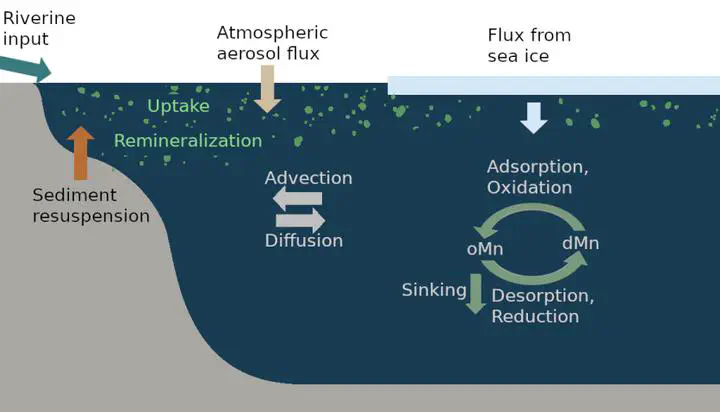Trace element cycling in the Arctic Ocean
 Schematic of key processes controlling dissolved Mn concentrations in the Canadian Arctic ocean.
Schematic of key processes controlling dissolved Mn concentrations in the Canadian Arctic ocean.Trace elements occur in concentrations less than 10 µmol/kg in the environment. Despite their small concentrations, trace elements can be essential micronutrients, harmful pollutants, and can “trace” oceanic processes [Bruland et al., 2013]. As tracers, they are useful tools to study the movement of water masses, as well as the sources, sinks, and processes that (re)distribute biogeochemical constituents in the ocean [Karcher et al., 2012].
Over the last few decades, the capacity to measure the concentrations of trace elements in the ocean has expanded through technological advances, global campaigns, and regional campaigns targeted at under-sampled regions like the Arctic Ocean. The field of trace element oceanography became established in the 1970s as the development of clean-sampling protocols resolved previous contamination issues [Anderson, 2020, Schaule and Patterson, 1981]. Over the next decades, international programmes developed knowledge of global circulation patterns, biogeochemical cycling, and atmosphere-ocean coupling. Yet, there remained geographical gaps in trace element measurements which made it difficult to address linkages with global biogeochemical cycles. Starting in the late 2000s, the international GEOTRACES programme aimed to address this problem with a systematic global study of trace elements and their isotopes [SCOR Working Group, 2007].
The multidisciplinary GEOTRACES programme has increased the number of ocean trace element observations by orders of magnitude, transforming our understanding of the ocean’s biogeochemical cycling and distributions of trace elements [Anderson, 2020]. Concurrent to the increase in trace element observations, computational capacity improved with increased model resolution, more sophisticated representations of processes, and improved numerical techniques, allowing biogeochemical models to become increasingly prevalent in oceanography. The GEOTRACES datasets have set the stage for the next generation of trace element model studies to investigate the key drivers of trace element distributions.